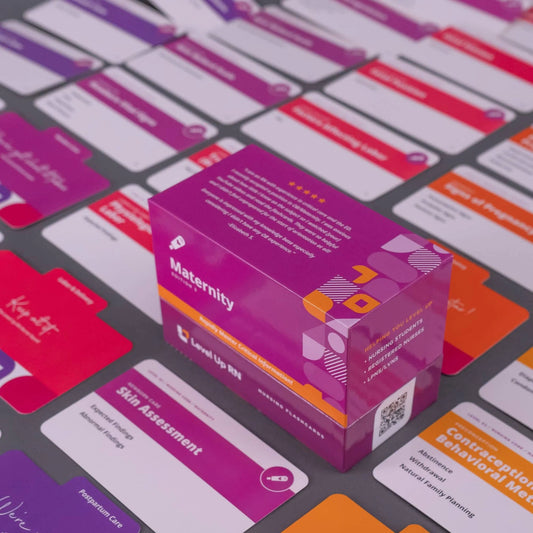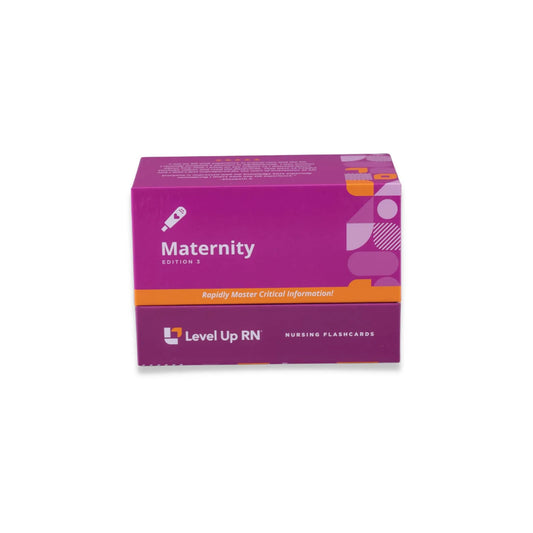Maternity Nursing - Flashcards
In this article, we discuss gestational diabetes mellitus (GDM), a complication that can occur during pregnancy.
This series follows along with our Maternity Nursing Flashcards, which are intended to help RN and PN nursing students study for nursing school exams, including the ATI, HESI, and NCLEX.
 When you see this Cool Chicken, that indicates one of Cathy's silly mnemonics to help you remember. The Cool Chicken hints in these articles are just a taste of what's available across our Level Up RN Flashcards for nursing students!
When you see this Cool Chicken, that indicates one of Cathy's silly mnemonics to help you remember. The Cool Chicken hints in these articles are just a taste of what's available across our Level Up RN Flashcards for nursing students!
What is gestational diabetes mellitus (GDM)?
Gestational diabetes (GDM) is diabetes that occurs during pregnancy in someone who is not diabetic. A patient with gestational diabetes will have impaired glucose tolerance during their pregnancy.
Risk factors for GDM
The risk factors for GDM parallel those for diabetes mellitus and include obesity, hypertension (HTN), having a family history of diabetes mellitus, or having had gestational diabetes mellitus during a previous pregnancy.
Signs and symptoms of GDM
A patient with gestational diabetes is usually asymptomatic, which is why it’s important to screen for this condition. If the patient does display signs or symptoms, these will be the same as for a person with diabetes, and include polyuria and polydipsia — excessive urination and excessive thirst — which are the most common. Remember, however, that pregnancy will cause a patient to urinate more frequently than normal to begin with, which makes polyuria hard to distinguish as a diabetes-specific symptom.
Labs and diagnostics for GDM
Patients experiencing pregnancy will be screened for GDM via an oral glucose tolerance test, or OGTT. This test takes one hour to be performed. Patients who fail the one-hour test will take a three-hour version of the test, which will diagnose gestational diabetes.
You can learn more about diabetes screening, labs, and more with our Lab Values Study Guide & Flashcard Index, a list of lab values covered in our Lab Values Flashcards for nursing students.
Treatment for GDM
Treatment for GDM, as with diabetes, will require the patient to undergo lifestyle modifications, which may include increasing the amount of exercise they get and changing their diet to include fewer carbs.
Patients should be taught how to monitor their blood glucose. In some cases, insulin may be required. Note that most oral diabetic medications are contraindicated during pregnancy.
Complications of GDM
Among the complications of GDM is fetal macrosomia — “macro” meaning large and “soma” meaning body — that is, a large-sized newborn. If the patient gave birth to a very large baby, that may indicate that the patient had undiagnosed gestational diabetes.
Another serious complication is that the baby is at risk for neonatal hypoglycemia. If the mother had elevated blood sugars while pregnant (even if it’s controlled with lifestyle modifications or medicines), there may still be an impairment of their glucose tolerance, as a lot of that sugar will be passed on to the baby. Once the baby is born and no longer gets all that sugar, the baby's blood sugar will crash. A baby that is macrosomic (that has a large body size) is therefore at risk for hypoglycemia.
Further complications for a patient with gestational diabetes include pre-eclampsia (birth trauma), requiring a c-section (in order to deliver a large baby), and the possibility that they continue to experience diabetes following their pregnancy.
Patient teaching for GDM
If a patient has gestational diabetes, they need to be monitored in the postpartum period to make sure that they return to their baseline. Note that they are still at higher risk for developing diabetes mellitus after pregnancy, which means they need to have a repeat oral glucose tolerance test once they are no longer pregnant to make sure that they return to their baseline.
Learn more about diabetic medications and more with our Pharmacology Second Edition Flashcards.
Hypoglycemia and Hyperglycemia
A patient with gestational diabetes will have similar signs and symptoms of hypoglycemia and hyperglycemia (diabetic ketoacidosis (DKA)) as a patient with diabetes.
Hypoglycemia
Hypoglycemia is low blood sugar.
Signs and symptoms of hypoglycemia
A patient who is hypoglycemic will have a characteristic look. They will be diaphoretic (sweat profusely) and their skin will be cold and clammy. A patient with hypoglycemia may have a headache or shakiness, they could have blurred vision, and they may suffer from hunger.
Treatment for hypoglycemia
 Skin — cold and clammy, need some candy!
Skin — cold and clammy, need some candy!
A hypoglycemic patient needs to be treated with sugar (hence the Cool Chicken mnemonic). 15 grams of a quickly absorbed carbohydrate, for example a 4 – 6 oz juice or 8 oz milk, (something that has that glucose in it) should be administered, followed by some form of protein intake. Protein is important, because if the treatment only replaces the glucose, the patient will crash again. Protein is a sustained energy source, so the patient is less likely to crash.
Hyperglycemia
Hyperglycemia means the patient's blood sugar is too high.
Signs and symptoms of hyperglycemia
Hallmark signs for hyperglycemia are the three Ps: polydipsia, polyphagia, and polyuria.
- Polydipsia: excessive thirst
- Polyphagia: excessive hunger
- Polyuria: excessive urination
Hyperglycemic patients will also have warm skin that is very dry. Their breath may have a fruity odor, indicative of seriously high blood sugar levels. And their breathing will tend to be rapid, indicating that they are experiencing Kussmaul's respirations — a compensatory mechanism for metabolic acidosis. Fatigue is another symptom of hyperglycemia.
Treatment for hyperglycemia
 Skin — warm and dry...sugar is high!
Skin — warm and dry...sugar is high!
A patient with hyperglycemia should be treated with insulin, and the provider should be notified immediately.


